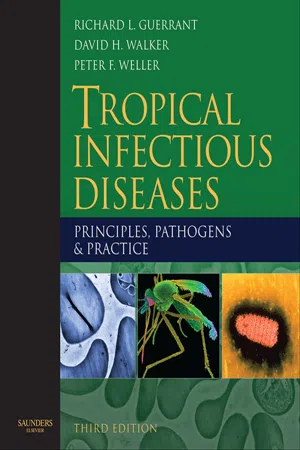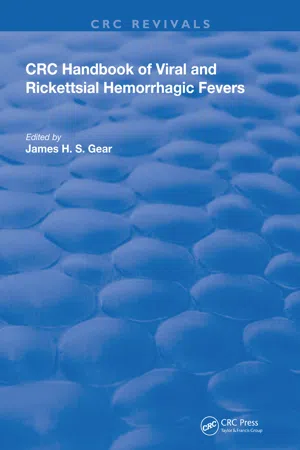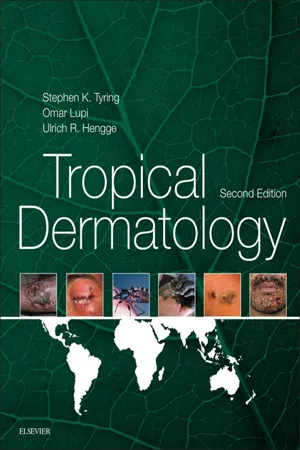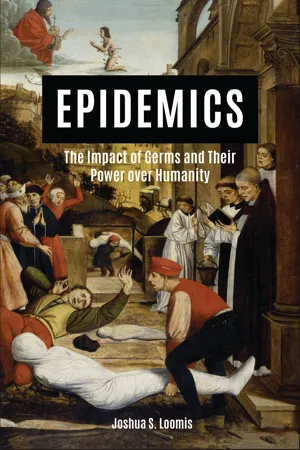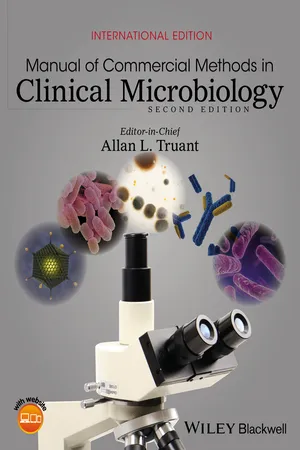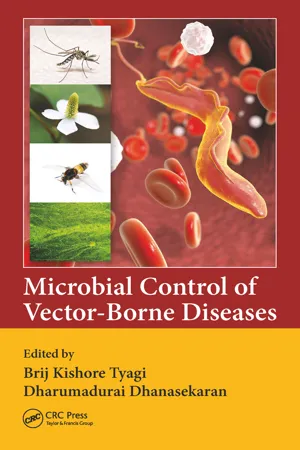Biological Sciences
Typhus
Typhus is a group of infectious diseases caused by bacteria transmitted by lice, fleas, or mites. Symptoms include fever, headache, and rash, and severe cases can lead to organ failure and death. Historically, typhus has been associated with crowded and unsanitary living conditions, and outbreaks have occurred during wars and natural disasters.
Written by Perlego with AI-assistance
Related key terms
12 Key excerpts on "Typhus"
- eBook - ePub
Death and Survival in Urban Britain
Disease, Pollution and Environment, 1800-1950
- Bill Luckin(Author)
- 2015(Publication Date)
- I.B. Tauris(Publisher)
However, there is also a strong case for tracing the natural history of an infection over a much shorter period, and in a deliberately delimited geographical area. This latter approach makes it possible to juxtapose the regional against the national pattern; to undertake a detailed analysis of the final phase of an epidemiological downswing; and to analyse concepts which have traditionally dominated discussion of ‘fever’ and its demographic significance. Each of these aspects is explored in this chapter, beginning with a brief account of the principal characteristics of Typhus and typhoid, and an explanation of the inability of so many medical practitioners to make a firm distinction between the two conditions until the later nineteenth century.Rickettsial and bacterial pathwaysTyphus is a rickettsial infection which thrives in conditions of acute social dislocation, poverty and overcrowding and is principally, though not exclusively, encountered during the cold months of the year.7 Rickettsia prowazeki, the infectious organism, which was first isolated in 1909, is transmitted from person to person by the body louse. The rickettsiae are ingested when the louse draws in blood from an individual already suffering from Typhus; then, when this blood meal has been digested, the microorganisms are ejected with the faeces. In crowded and dirty living conditions, where lice and fleas proliferate, surface lesions, caused either by the bite of an insect or by the scratching of a persistent irritation, are inevitably common; and Typhus is most usually spread when the rickettsiae contained in the faeces of lice are rubbed into broken skin. Once the disease has been contracted, the sufferer is afflicted by a severe headache and a very high temperature; and the entire body, except for the face, the palms of the hands and the soles of the feet, becomes rapidly disfigured by angry red spots. During an intense epidemic the case fatality rate may rise to more than 50 per cent; but during the nineteenth century it probably ranged between about 20 and 45 per cent.8 - Richard L. Guerrant, David H. Walker, Peter F. Weller(Authors)
- 2011(Publication Date)
- Saunders(Publisher)
CHAPTER 50 Typhus Group RickettsiosesDavid H. Walker, Didier RaoultAccess the complete reference list online at http://www.expertconsult.comIntroduction
Murine Typhus, usually misdiagnosed as another ailment, is among the most prevalent febrile illnesses in the tropics.1 - 5 Louse-borne Typhus is historically one of the most devastating infections and a continuing cause of morbidity and mortality among isolated, impoverished populations.6 Rickettsiae are small, obligately intracellular, Gram-negative bacteria that have an arthropod host as at least a portion of their ecologic niche. The Typhus group comprises Rickettsia prowazekii (epidemic louse-borne Typhus, recrudescent Typhus, and flying squirrel-associated Typhus) and R. typhi (murine Typhus). Typhus infections were first described by Fracastorius in 1546 based on observations during an Italian epidemic in 1528.7, 8 Half of the deaths among Napoleon’s 700 000 soldiers during the Russian campaign of 1812 were likely caused by Typhus, just one example of the tremendous effect of Typhus on history.9 Milder forms of Typhus described by Brill in 1898 in New York among emigrees from European Typhus zones and by Paullin in 1913 in Atlanta were proved during the 1930s to be recrudescent R. prowazekii infection and rat flea-transmitted R. typhi infection, respectively.10 - 15 Antibiotic-resistant R. prowazekii strains have been developed, and both R. prowazekii and R. typhi are aerosol-transmitted biothreats.16 - 18- eBook - ePub
- Irwin W. Sherman(Author)
- 2017(Publication Date)
- ASM Press(Publisher)
Nicolle also solved another mystery: he noticed that Typhus tended to occur in individuals who were unable to clean themselves of their body lice and lice-infested clothing—in particular criminals lodged in the filthy jails—and that “prison fever” could spread from felon to judge, not by foul-smelling air but through infected lice. In September 1909 he wrote that it was obvious that Typhus was transmitted by lice. Nicolle received the 1928 Nobel Prize for his work on the transmission of Typhus; the discovery of the causative agent of Typhus, however, was left to others.Typhus is not the same as typhoid fever, which is a waterborne disease caused by a bacillus, Salmonella. Today we know the causative agent of the disease Typhus to be a bacteria-like organism, Rickettsia prowazekii, related to the organisms that produce Rocky Mountain spotted fever, Rickettsia rickettsii, described by H. T. Ricketts in 1906, with a tick vector and a fatality rate of 20%. Rickettsias are small, oblong, Gram-negative bacteria-like organisms (Fig. 6.5 ) that are intracellular parasites. Rickettsias range in size from 0.3 to 0.6 µm and therefore are of intermediate size between viruses and bacteria.Howard Ricketts (1871-1910) described the infectious agents responsible for both Rocky Mountain spotted fever and Typhus. Ricketts graduated from Northwestern University Medical School, and before taking up a position as an assistant professor of pathology at the University of Chicago, he traveled to the Pasteur Institute in Paris. There he became a bona fide microbe hunter. In the spring of 1906, Ricketts went to Montana to study “spotted fever,” and while examining stained specimens of blood from infected monkeys and guinea pigs, he found “a bipolar bacillus.” He saw the same bacillus in humans suffering from the disease; however, despite his training in standard techniques of bacteriology, such as culturing in nutrient broth and on blood agar, all attempts on his part to grow these bacilli failed. Ricketts did note that “spotted fever” was associated with people who had tick bites, and upon examining the salivary glands and gut of ticks that had fed on infected guinea pigs, he found the telltale microbe. But when ticks were fed on uninfected guinea pigs, no such microbes were seen. He concluded that this “spotted fever” of the Rocky Mountains was transmitted by the bite of ticks that carried the “bipolar bacilli.” - James H.S. Gear, James H.S. Gear(Authors)
- 2019(Publication Date)
- CRC Press(Publisher)
Louse-borne Typhus fever ranks among the top epidemic diseases causing suffering and death. The greatest recorded epidemics occurred in Russia and eastern Poland during 1915 to 1922, when Typhus afflicted 30 million inhabitants and caused an estimated 3 million deaths. Now the scourge is under control, largely through better hygienic methods and improvement in socioeconomic standards. Yet, it occurs in underdeveloped countries in Asia, in Africa (e.g., Ethiopia and Burundi), and in the highlands of Central and South America (e.g., Mexico, Peru, and Columbia), where it is endemic. It occurs during the cold winter months when lousiness is more prevalent.Epidemic Typhus now occurs in the U.S. as a flying squirrel-(Glaucomys volans ) related illness. For the years 1977 to 1982, in excess of 30 human squirrel-related Typhus cases were reported by the Center for Disease Control in various eastern states. The disease is milder than the classic form and is nonfatal.14The clinical differentiation between Typhus and typhoid fever was established by Gerhard in 1836, based on clinical observations and post-mortem findings.15 Murchison gave the classic description of the illness in 1884.16 Following Ricketts’ description of R. rickettsii 8in 1906, Nicolle, working in Tunisia, reproduced Typhus fever in monkeys and demonstrated transmission by the body louse.17 Brill, in New York, recognized a febrile disease which resembled Typhus and was unassociated with lousiness18 , now known as recurrent Typhus or Brill-Zinsser disease.19- eBook - ePub
- Steven K Tyring, Omar Lupi, Ulrich R Hengge(Authors)
- 2016(Publication Date)
- Elsevier(Publisher)
23Rickettsial Infections
Ramya Kollipara, Stephen K. TyringChapter OutlineIntroduction Rickettsia–Host Cell Interaction Mechanisms of Cell Injury Pathophysiology Mechanisms of Tissue and Organ Damage Host Defenses Gaps in Scientific Knowledge The Spotted Fever Group Mediterranean Spotted Fever History Etiologic Agent Epidemiology Clinical Manifestations Patient Evaluation, Diagnosis, and Differential Diagnosis Treatment Prevention North Asian Tick Typhus (Siberian Tick Typhus) Oriental Spotted Fever Queensland Tick Typhus Epidemiology Clinical Manifestations Diagnosis Treatment Rocky Mountain Spotted Fever Epidemiology Clinical Manifestations Diagnosis Treatment Rickettsialpox Epidemiology Clinical Manifestations Diagnosis Treatment The Typhus Group Epidemic Typhus Epidemiology Clinical Manifestations Diagnosis TreatmentVaccine for R. ProwazekiiBrill–Zinsser Disease Murine Typhus (Endemic Typhus) Epidemiology Clinical Manifestations Diagnosis Treatment Scrub Typhus Epidemiology Clinical Manifestations Diagnosis Treatment Rickettsial Infections and Bioterrorism ConclusionKey PointRickettsiae are obligately intracellular, Gram-negative bacteria that are transmitted when arthropods feed on humans. An important clue to diagnosing rickettsial disease is the eschar that forms at the site of an arthropod bite.First-line therapy for rickettsial infection consists of a tetracycline or chloramphenicol. Prompt administration of appropriate antibiotic therapy is the most effective measure for minimizing disease and preventing fatalities. - eBook - ePub
Epidemics
The Impact of Germs and Their Power over Humanity
- Joshua S. Loomis(Author)
- 2018(Publication Date)
- Praeger(Publisher)
Epidemic Typhus has had significant impacts on nearly every major war fought on the European and Asian continents for over four-and-a-half centuries. During the course of almost every war, large numbers of soldiers are forced to mobilize to specific locations and live in close contact with one another in overcrowded and often unsanitary tents and barracks for months or even years. In doing so, they will wear the same dirty, unwashed uniform for days on end, share bedding and blankets, and huddle closely in the face of enemy onslaughts and harsh winters. Similarly, violent battles often cause major displacements of civilians and the consequent creation of unimaginably cramped refugee and concentration camps. Food supplies in battlefields and camps were always limiting, creating widespread malnourishment and weakened immune systems. Altogether, the congested and unhealthy living conditions that almost universally result from warfare provide a perfect breeding ground for infectious diseases and the parasites that carry them. One such parasite, the human body louse, is particularly adept at flourishing within the confines of an active war zone. Body lice are able to jump easily from host to host through any direct physical contact or sharing of clothing/bedding. Through its ability to transmit the bacterium that causes epidemic Typhus, the simple louse has drastically affected the outcome of several very important battles in history and humbled some of the most brilliant military minds (e.g., Napoleon Bonaparte).Epidemic Typhus is caused by infection with the bacterium Rickettsia prowazekii. It is different from other human Typhus diseases like murine and scrub Typhus in that it has an abnormally high fatality rate and is transmitted by lice rather than by ticks, fleas, or mites. When a louse carrying R. prowazekii bites a human, it typically defecates on the skin as it takes its blood meal. Chemicals in the louse saliva cause an inflammatory itching response, which prompts the person to scratch the area. That scratching creates small, microscopic abrasions in the skin and ultimately provides an opening by which the bacteria are able to enter the body. Once inside, R. prowazekii bacteria promptly reach the bloodstream and attach to the cells that line the blood vessels (called vascular endothelial cells).Unlike most bacterial pathogens, which usually do their damage while living outside of our cells, R. prowazekii forces its way into the interior of the endothelial cells and begins to replicate there. Overwhelmed with bacteria, infected cells become sickly and eventually burst. Newly made R. prowazekii - eBook - ePub
- Dwight D. Bowman(Author)
- 2020(Publication Date)
- Saunders(Publisher)
Raoult et al, 2004 ). At present, only specialized laboratories with federal approval are allowed to conduct research with this agent.Murine Typhus caused by R. typhi is maintained in a rodent-flea cycle and is transmitted to people through wound contamination with flea feces; flea feeding has also been suggested as a route for infection. Endemic areas of R. typhi transmission are supported by flea infestations on dogs, cats, and opossums (Boostrom et al, 2002 ; Williams et al, 1992 ). Human infection results in fever, headache, myalgia, confusion, and, in approximately half of patients, a diffuse rash (Civen and Ngo, 2008 ). The disease is considered endemic in parts of Hawaii, California, and Texas, and is sporadically reported from other areas (Adjemian et al, 2010 ). A related organism, R. felis, is considered an agent of flea-borne spotted fever and is also transmitted by C. felis (Parola, 2011 ). Sylvatic Typhus in North America is also caused by R. prowazekii but is associated with exposure to the reservoir host, the southern flying squirrel (Glaucomys volans); an arthropod vector has not yet been identified (Chapman et al, 2009 ). Cases of sylvatic Typhus tend to be less severe than epidemic Typhus, with patients developing fever, headache, and malaise, but no rash. Sporadic relapse of previous R. prowazekii infection owing to waning immunity may lead to Brill-Zinsser disease in some patients (Faucher et al, 2012 ; McQuiston et al, 2010 ).Mites transmit some rickettsial pathogens as well. For example, Rickettsia akari, causative agent of rickettsialpox, a nonfatal febrile disease of people that is predominantly seen in urban areas, is transmitted between mice and to humans through the feeding of Liponyssoides sanguineus, a murine mite. Infection with R. akari results in a febrile disease accompanied by eschar and a diffuse papulovesicular rash (Paddock et al, 2006 ). Another mite-transmitted disease is scrub Typhus, which is caused by Orientia tsutsugamushi. Predominantly seen in Asia and Australia, O. tsutsugamushi is transmitted to people by trombiculid mites (Boyd, 1997 ; Chattopadhyay and Richards, 2007 ); autochthonous cases have been reported from the Americas (Weitzel et al, 2016 ). Classically, patients with scrub Typhus present with fever, rash, and eschar, although fever of unknown origin is also described (Koh et al, 2010 - (Author)
- 2016(Publication Date)
- Wiley-Blackwell(Publisher)
CHAPTER 11 Rickettsiae and Tick-borne DiseasesNatalie Williams-Bouyer, Donald H. Bouyer, and Michael J. LoeffelholzDepartment of Pathology, University of Texas Medical Branch, Galveston, TX, USA11.1 Introduction
Tick-borne diseases (TBDs) are increasing in prevalence and represent a growing occurrence of arthropod-borne infectious diseases. Possible reasons for this phenomenon include shifts in the distribution of animal reservoirs and tick vectors, as well as more human presence in areas where there is increased contact with ticks and their associated pathogens. From a public health point of view, the complex interactions of ticks, pathogens, hosts, and the environments involved in this changing pattern of disease are not completely understood [14, 49, 50, 58, 59]. However, the reporting of these illnesses and diseases to health department agencies allows for the gathering of information and statistics, in support of establishing trends related to these illnesses [11].Tick-borne illnesses occur in distinct geographic locations, which is a key factor in determining specific tick-borne infections to be considered in diagnosis. Patients with TBD often present with nonspecific symptoms, including various rashes or skin lesions, which are often accompanied by fever and influenza-like symptoms [4]. Travel history, recent locations, and potential for tick bite are important. However, individuals are usually unaware of tick exposure and less than 50% present with a positive history of a tick bite [12, 26, 33]. Nonetheless, the absence of a tick-bite history should not exclude a diagnosis given the correct clinical presentation. Severe illness and mortality can occur, if there are delays in diagnosis and treatment.Since the organisms transmitted by ticks are infrequently encountered in clinical specimens, diagnosis of tick-borne diseases can pose a challenge in that the etiologic agents of these illnesses can be both difficult and hazardous to culture in laboratories. Therefore, clinical specimens for culture, molecular analysis, and some serologic assays are commonly referred for diagnosis at specialized laboratories utilizing specific testing methodologies [4]. This chapter discusses the most common agents associated with TBD and details the testing methodologies currently available for laboratory diagnosis.- eBook - ePub
- Heiman F. L. Wertheim, Peter Horby, John P. Woodall, Heiman F. L. Wertheim, Peter Horby, John P. Woodall(Authors)
- 2012(Publication Date)
- Wiley-Blackwell(Publisher)
www.kolonin.org , and updated with recent publications and expert opinion.Key referencesParola P, et al. (2001) Ticks and tickborne bacterial diseases in humans: an emerging infectious threat. Clin Infect Dis 32 : 897–928.Parola P, et al. (2005) Tick-borne rickettsioses around the world: emerging diseases challenging old concepts. Clin Microbiol Rev 18 (4): 719–756.Passage contains an image Chapter 47 Disease: Scrub Typhus
Classification : ICD-9 081.2; ICD-10 A75.3Syndromes and synonyms : Tsutsugamushi disease, mite-borne Typhus fever, chigger-borne rickettsioses, coastal fever (Australia).Agent : Orientia tsutsugamushi , obligate intracellular bacterium, before 1995 known as Rickettsia tsutsugamushi . In 2010, a new species that can cause scrub Typhus was discovered in Dubai, O. chuto .Reservoir : Larval stage mites, so-called chiggers from the genus Leptotrombidium . A number of small rodents, particularly wild rats, are the natural hosts for scrub Typhus without apparent disease.Vector : Larval mites. Nymphs and adults do not feed on vetebrate hosts. The vector has adapted to various ecologies, including mountainous and tropical regions.Transmission : Bite of infected larval mites (chiggers). There is no direct person-to-person transmission.Cycle : The mites are infected by feeding on reservoir animals (small rodents), and maintain the infection throughout their life stages. The infection is passed on by transovarial transmission. O. tsutsugamushi are present in the salivary glands of the larvae and injected into the host during feeding.Incubation period : 10–12 days, range: 6–21 days.Clinical findings - eBook - ePub
- Brij Kishore Tyagi, Dharumadurai Dhanasekaran(Authors)
- 2018(Publication Date)
- CRC Press(Publisher)
V Microbial Control of Flea VectorPassage contains an image
21 Effective Microbial Compounds for Controlling Flea-Borne Rickettsial DiseasesArunachalam Chinnathambi * and Ravikumar Mathrubutham21.1 Introduction21.1.1 Natural History of Flea-Borne Rickettsial Diseases21.1.2 Indian Scenarios21.2 Laboratory Findings21.2.1 Differential Diagnosis21.3 Treatment of Flea-Borne Rickettsial Diseases21.3.1 Preventive Measures21.3.2 Control and Surveillance of Flea-Borne Rickettsial Diseases21.4 Concluding RemarksReferences21.1 IntroductionRickettsiae are the group of microorganisms that phylogenetically fills the gap between bacteria and viruses. Rickettsiae are vector-borne zoonotic infections caused by obligate intracellular bacteria of the genus Rickettsia belonging to alpha group of the phylum Proteobacteria. They are divided into four groups based on their genotypic characteristics, namely, spotted fever group (SFG) (R. rickettsii, R. conorii, R. parkeri , and several others), Typhus group (TG) (R. prowazekii and R. typhi ), transitional group (R. felis, R. akari , and R. australis ), and the nonpathogenic ancestral group (R. bellii and R. canadensis ) (Mansueto et al., 2012). R. typhi (known in the old literature as R. mooseri ) and R. felis are the etiological agents of murine Typhus and flea-borne spotted fever. Both bacteria produce a flu-like febrile syndrome, frequently accompanied by rash.Rickettsia is the member of the TG of rickettsiae and closely resembles the other member of that group R. prowazekii in its genetical, biological, and immunological characteristics. Normally, commensal rats belonging to the genus Rattus are the primary zoonotic reservoir of R. typhi , followed by the oriental rat flea, Xenopsylla cheopsi , which is the classic vector that transmits murine Typhus to humans.Humans are the prime reservoir for R. prowazekii where the pathogen persists despite humoral and cellular immune responses. While clinically seeking, epidemic Typhus is fatal in 10% to 50% of untreated patients and is more likely to be fatal in human communities with concurrent malnourishment (Eremeeva and Dasch, 2015). Ctenocephalides felis yet more than 20 other species of fleas, ticks, and mites species have been reported to harbor R. felis , which may pose an adverse impact on human health with changes to the ecology and distribution of R. felis - eBook - ePub
I Speak of the City
Mexico City at the Turn of the Twentieth Century
- Mauricio Tenorio-Trillo(Author)
- 2015(Publication Date)
- University of Chicago Press(Publisher)
Mexican scientists’ emphasis on the history and locality of the disease allowed bacteriologists to conclude what Zinsser summarized in his biography of the disease: “Man, in the biological sense, is a recent host, and in him Rickettsia invasion arouses a physiological resentment. A struggle between invader and host ensues which manifests itself as disease.” In such a way the evolutionary argument was completed. 58 Until his death in 1940, Zinsser was engaged in vaccine production with Ruiz Castañeda and others. But Rats, Lice, and History already marked, with uncanny clairvoyance, the different paths the struggle against Typhus would take over World War II. He pointed to anti-lice campaigns as the key to preventing and eliminating the disease, utilizing the louse as a twofold justification: of the chemical war against it, and of the struggle against Nazi Germany. “Unlike the flea,” he argued, “[the louse] can neither hop nor live for any length of time separated from its human host, it possesses qualities of dogged persistence and patient diligence which arouse that admiration, thinly masked by a pretense of loathing, which men similarly feel for competing races whom they fear and, therefore, persecute.” And he added, as a clarification of this last sentence: “we refer to the blond Aryan complex.” 59 In 1940, while returning from China, Hans Zinsser realized that he had developed leukemia. The doctor cum poet wrote: Now is death merciful - eBook - ePub
On the cattle plague
or, Contagious typhus in horned cattle. Its history, origin, description, and treatment
- Honoré Bourguignon(Author)
- 2011(Publication Date)
- Perlego(Publisher)
rinderpest , would carry us too far back.Let us acknowledge also, that the denomination of contagious Typhus, adopted by the French veterinary doctors, is not, any more than the designation of Typhus fever , applied to it by English physicians, totally free from objection.In truth, the various species of Typhus whose characteristics we have already given (see p. 73), are all of them febrile and contagious. Whoever uses the word Typhus, speaks of a contagious and febrile malady, inasmuch as we cannot conceive Typhus without its accompaniments, fever and contagion. But as the prevailing characteristic of this infectious disease is, above all, its contagion, we have preferred to adopt the name of contagious Typhus, without, however, deceiving ourselves as to the value of the denomination. The final elucidation has not yet been found for these diseases; at some future day they will be methodically divided and arranged, and each of them will then receive a special title, which will remove from the mind that vague uncertainty which at present we regret.But if some faults of doctrine are open to debate, no doubt whatever can exist in the mind as to the morbid individuality of ox-Typhus, or the general conditions of its pathogenia; and we are able to deduce from the preceding explanation, the following conclusions as so many propositions definitively settled:—1st. The Typhus of the ox is a disease essentially infectious, which is produced by the absorption of the morbigenous miasma in the air. 2nd. This typhic miasma is absorbed and engendered by the ox, under the influence of a number of special deleterious causes.3rd. When the miasma has been absorbed and incubation produced, the disease itself is but a supreme effort of nature—a struggle between the vital forces and the morbid evolution of the poison, in order to guard and defend life against the danger which threatens it.
Index pages curate the most relevant extracts from our library of academic textbooks. They’ve been created using an in-house natural language model (NLM), each adding context and meaning to key research topics.

